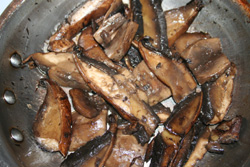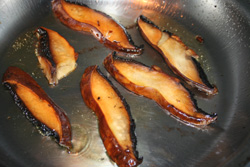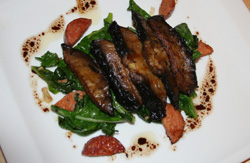Effects of Maillard Reaction during Cooking
Why the same dish may taste different when different chefs cook it.
How many times have you cooked a steak or sautéed one of your favorite cuts of meat and felt it may have tasted better the time before, or perhaps this time was the best it's been? It may not be the meat but instead the Maillard reaction doing it's own game. The Maillard reaction , a complex reaction between sugars and amino acids, produces hundred of aromatic, flavorful by products. The Maillard reaction is not limited to meat or fish but to all foods that contain protein.
The main problem is that the Maillard reaction is both time and temperature dependent. This makes it nearly impossible to produce the exact same products every time the dish a cooked. For the expert chef who is keen on handling time and temperature, and knows what to look for when cooking, the taste may not be much different from one dish to another. However, to the home cook or beginning chef who does not take into account such variables as: change in meat thickness, time for searing, flame intensity etc., major differences from one dish to another can occur.
Differences may not only be due to Maillard reaction but to Caramelization which occurs when sugar is heated. As with the Maillard reaction numerous complex products are formed with many different flavors.
Crowding food prevents the Maillard reaction
Water is a foe to the Maillard reaction; it lowers the temperature of the system and greatly minimizes the reaction.
Using high heat may not guarantee flavorful Maillard reaction products if too much water is released from food. A classic example is shown below when mushrooms are sautéed using the same intensity of heat.


Image Left: Overcrowding mushrooms release water and prevents maillard reaction, Image Right: Giving mushrooms room allows higher temperature and maillard reation to occur.
Portabello mushrooms were sautéed using olive oil over a medium-high flame in both cases. Crowding the pan as well as moving the mushrooms around will yield moisture from the mushrooms. This will lower the temperature and prevent proper browning (left side). When the mushrooms are allowed to sit in an uncrowded environment, water will evaporate and browning will occur. The end result is a golden, meaty, tasting mushroom thanks to a combination of Maillard and Caramelization reactions.
Because the Maillard Reaction is time and temperature dependent the flavors of mushroom cooked over an oven flame (grilled) are different, as is the appearance. Below Image of Grilled Portabello Mushrooms shown with Market Pheasant Sausage and Bitter Greens.

Key Factors
Pentose sugars react more than hexoses, which react more than disaccharides.
Different amino acids produce different amounts of browning.
Since the Maillard reaction produces water, having a high water activity environment inhibits the reaction.
See also:
Why red meat turns brown when vacuum sealed.
Important temperatures in cooking
External links
References
- An Expeditious, High-Yielding Construction of the Food Aroma Compounds 6-Acetyl-1,2,3,4-tetrahydropyridine and 2-Acetyl-1-pyrroline Tyler J. Harrison and Gregory R. Dake J. Org. Chem.; 2005; 70(26) pp 10872 - 10874; (Note) DOI: 10.1021/jo051940a Abstract
- Nahid Tamanna , and Niaz Mahmood. (2015) Food Processing and Maillard Reaction Products: Effect on Human Health and Nutrition. Int J Food Sci. 2015; 2015: 526762.